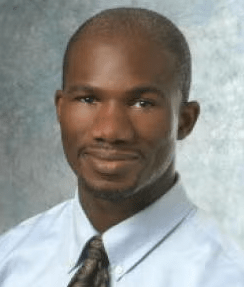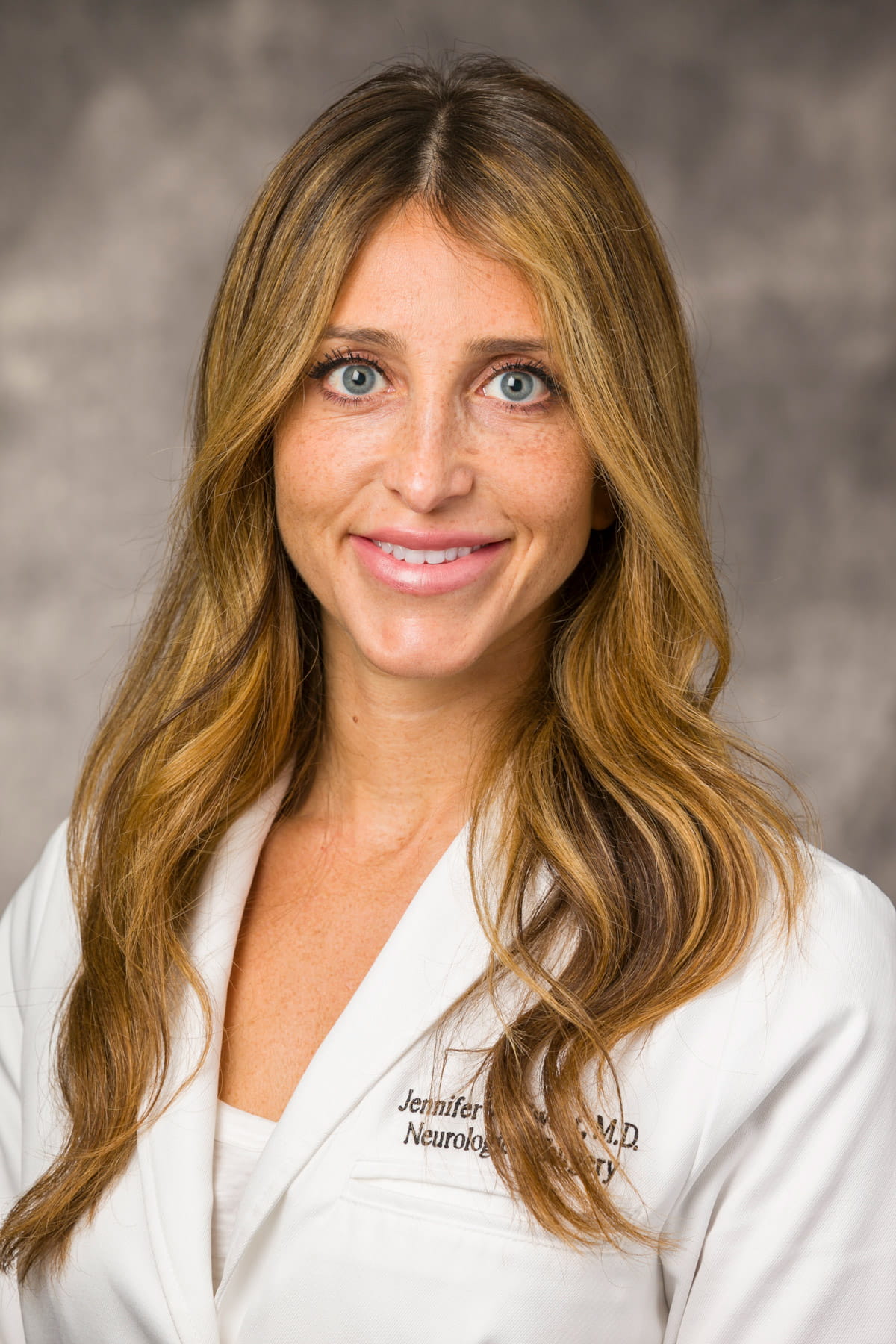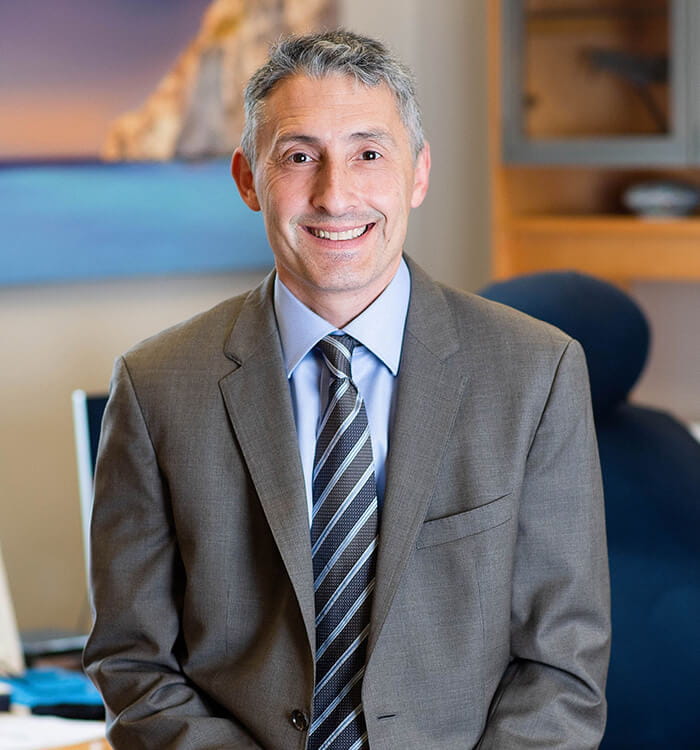Groundbreaking ReHAB Study Seeks to Restore Purposeful Movement in Patients with Paralysis
July 14, 2025
Innovations in Neurology & Neurosurgery | Summer 2025
Pioneering researchers at University Hospitals Cleveland Medical Center and Case Western Reserve University are conducting a groundbreaking ReHAB (Reconnecting the Hand and Arm to the Brain) clinical trial. The study evaluates the safety and efficacy of a next-generation brain-computer interface (BCI) designed to restore purposeful hand and arm movement in individuals experiencing paralysis due to spinal cord injury or stroke.
 Abidemi Bolu Ajiboye, PhD
Abidemi Bolu Ajiboye, PhD Jennifer Sweet, MD
Jennifer Sweet, MD Nichols C. Bammakidis, MD
Nichols C. Bammakidis, MD“The ReHAB study is a stellar example of the ongoing collaboration between the UH Neurological Institute and biomedical engineers at Case Western Reserve University, exemplifying the groundbreaking research we are known for,” says Nicholas C. Bambakidis, MD, President of the University Hospitals Neurological Institute, the Harvey Huntington Brown, Jr. Chair in Neurosurgery at University Hospitals. “Helping people with paralysis regain movement in their limbs is a lofty goal; the surgeries have been successful, and early results are promising.”
The ReHAB system consists of multiple microelectrode arrays surgically implanted in the brain that communicate with high-density nerve cuff electrodes placed along peripheral nerves of the patient’s hand, arm and shoulder. This breakthrough in neuroprosthetics enables the study participant to control movement with their thoughts and provides sensory feedback to the brain.
“The BCI deciphers and records activity from cortical networks within the brain so that we can send that information to reanimate the limb,” says Abidemi Bolu Ajiboye, PhD, ReHAB Co-Principal Investigator (PI) and the Robert & Brenda Aiken Professor of Biomedical Engineering at Department of Biomedical Engineering, Case School of Engineering and School of Medicine. “When small amounts of current are applied in the right pattern of stimulation, we can generate functional movement of the limb.”
Research into implantable brain interfaces has been underway in Cleveland for many years. “There are a few hospitals actively implanting electrodes in the brains of patients with spinal cord injury or other forms of paralysis,” says Jennifer Sweet, MD, ReHAB Co-PI, the Sheila and Sandy Fox Master Clinician in Neurosurgery at University Hospitals. “We are the only program worldwide taking the next step of implanting electrodes along the nerves of the dominant paralyzed limb to bypass the spinal cord in an effort to transfer signals to the muscles and nerves in the arm.”
The 2019 documentary I Am Human featured Cleveland veteran Bill Kochevar, who received an implanted BCI six years prior to the film’s release. Sadly, Kochevar passed away from unrelated causes in 2017. Austin Beggin, who is quadriplegic, became the next participant to be implanted by Dr. Ajiboye and his team. His story of regaining movement in his arm was featured in a 2023 episode of 60 Minutes. “These are wonderful people who made tremendous contributions to advancing functional electrical stimulation through their willingness to participate in this research,” Dr. Ajiboye says.
Local and National Collaboration
ReHAB is supported by more than $10 million in combined grants from the U.S. Department of Defense, the National Institutes of Health and the U.S. Department of Veterans Affairs (VA). Researchers have also secured investigational device approval from the U.S. Food and Drug Administration. The feasibility trial is currently recruiting patients and seeks to enroll up to 12 participants.
Another partner in the quest to advance neurostimulation is the Cleveland Functional Electrical Stimulation (FES) Center at the Louis Stokes Cleveland VA Medical Center. The center is led by Executive Director Robert Kirsch, PhD, who is also the Chair of Biomedical Engineering and a professor at Case Western Reserve University. “The center has been developing implantable medical technology to restore function in people with various levels of functional loss for nearly 40 years,” Dr. Ajiboye says.
ReHAB Journey Begins for Next Patient
On January 15, Dr. Sweet, a stereotactic and functional neurosurgeon, and Stanley Bazarek, MD, PhD, a peripheral neurosurgeon, performed extensive implantation surgery to expose the nerves along the newest study participant’s dominant arm.
“We did the arm surgery first and completed the brain implantation a couple of weeks later,” Dr. Sweet says. “Dr. Bazarek exposed the peripheral nerves, and we placed the electrodes based on the expert mapping of Dr. Ajiboye and the engineers.”
The participant is recovering well from the surgeries and is now beginning a rigorous process of working with the biomedical engineers. “We have brought this gentleman in for a few sessions to start interpreting data and working towards arm movement,” Dr. Ajiboye says. “He's excited to get going.” His journey to regain motion will require regular visits over multiple years.
Proprioception: The Next Frontier
“While we have been focusing for many years on successfully restoring movement, another major emphasis in our work is restoring the ability of people with paralysis to feel touch,” Dr. Ajiboye says.
Emily Graczyk, PhD, an assistant professor of Biomedical Engineering at Case Western Reserve University, develops and implements technology to restore and enhance somatosensory function for individuals with amputation, spinal cord injury or other sensory impairments. Her expertise in somatosensation and proprioception in the hand and arm is helping propel the next phase of the ReHAB team’s research.
“When individuals have a spinal cord injury, the sensors in the hand cannot transmit that input to the brain,” Dr. Ajiboye says. “We have to determine the right patterns and levels of stimulation to effectively restore that sense of touch.”
For more information, contact Dr. Sweet at Jennifer.Sweet@UHhospitals.org or Dr. Ajiboye at aba20@case.edu.
Contributing Experts:
Abidemi Bolu Ajiboye, PhD
Robert & Brenda Aiken Professorship in Biomedical Engineering
Case School of Engineering
Case Western Reserve University School of Medicine
Laboratory for Intelligent Machine-Brain Systems
Faculty Director for Postdoctoral Affairs
Office of the Provost
Case Western Reserve University
Biomedical Engineer/Research Scientist
Cleveland Functional Electrical Stimulation (FES) Center
Louis Stokes Cleveland VA Medical Center
Jennifer Sweet, MD
Director, Movement Disorder Surgery
Co-Director, Pain Surgery and Neuromodulation
University Hospitals Neurological Institute
Sheila and Sandy Fox Master Clinician in Neurosurgery
University Hospitals Cleveland Medical Center
Professor of Neurological Surgery
Case Western Reserve University School of Medicine
President
University Hospitals Neurological Institute
Harvey Huntington Brown, Jr. Chair in Neurosurgery
University Hospitals Cleveland Medical Center
Professor
Case Western Reserve University School of Medicine


